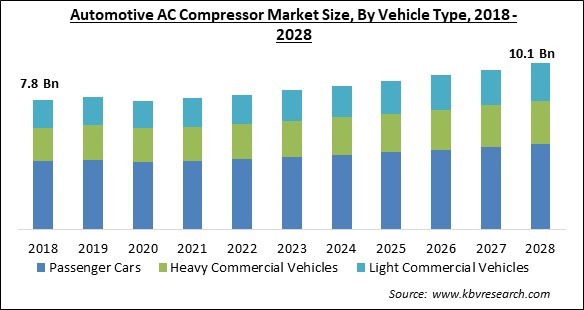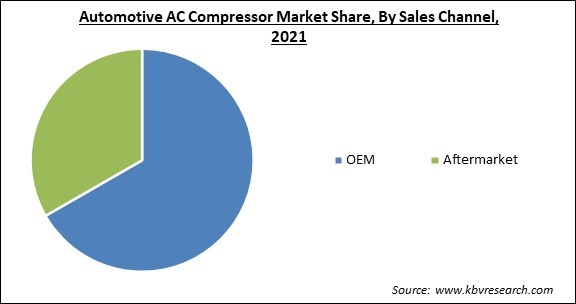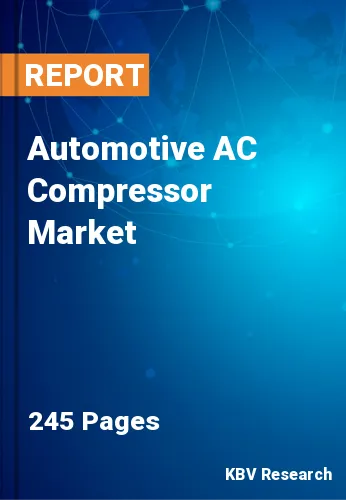The Global Automotive AC Compressor Market size is expected to reach $10.1 billion by 2028, rising at a market growth of 3.5% CAGR during the forecast period.
The automotive AC compressor in an automotive that removes the heat-laden vapor refrigerant out of the evaporator. The AC compressor is the engine that drives the air conditioner, applying intense pressure to the refrigerant before pumping it through the condenser, where the gas is transformed into a liquid. Due to the quick increase in vehicle manufacturing as well as the rise in the deployment of high-quality comfort accessories for cheap automobiles, the market is expected to grow significantly in the next years.

Additionally, the expansion of the automotive AC compressors market is aided by a rise in the utilization of vehicle air conditioning units in emerging regions. The compressor is the primary processor for the HVAC (heating, ventilation, and air conditioning) systems. The HVAC system is made to be environmentally friendly while still providing occupant comfort and operational efficiency. Electric compressors come with an integrated motor.
The built-in motor continues to run even when the vehicle's engine is off, improving fuel economy and allowing the AC to run continuously to keep the interior at a reasonable temperature. Additionally, the compressor in an electric car is in charge of cooling both the battery pack and the entire cabin. It guards against battery overheating, which prevents the car from breaking down. There are many different types of AC compressors for automobiles, out of which the swash plate kind of air conditioner compressor is the most popular.
The compressor, which is connected to the vehicle's engine block, is driven by a pulley and V-belt. Upon the initiation of AC system, an electromagnetic clutch starts the belt drive. This is accompanied by the oscillation of double-ended pistons by the swash plate. The refrigerant flow is controlled by the reed valves. The refrigerant then circulates and interacts with a fine oil mist to properly lubricate the moving parts.
The manufacture of vehicle AC compressors was severely impacted by the suspension of all industrial operations in China, the world's largest producer of raw materials and electricity. However, since China was the epicenter of the pandemic, exports were restricted, which caused a decline in the demand for automotive AC compressors. Throughout the COVID-19 outbreak, lockdowns caused a significant decline in vehicle manufacturing and sales, which hampered the growth of the economy. In addition, the COVID-19 pandemic's import-export restrictions, supply chain delays, and closed borders also had a significant influence on the total demand for AC compressors in the automotive industry.
The market demand is anticipated to increase as air conditioning is being used in passenger vehicles throughout developing nations. Additionally, car makers are constantly coming up with new ideas to increase the fuel economy of compressors due to a sharp increase in environmental requirements. This restricts emissions and helps the effort to combat global warming. Furthermore, the popularity of vehicles, such as hybrid and electric vehicles (EVs), is also causing manufacturers to release more innovative EV models in China, Japan, Europe, and North America, which is increasing the requirement for AC compressors.
The market is being significantly propelled by the prevalent hydrogen compression technologies. The automobile sector is moving towards sustainable growth, and hydrogen is presenting itself as a game-changer in making vehicles emission-free. Hydrogen exists as one of the elements with the highest abundance and is practically ubiquitous, acting as an endless source of energy. Fuel cells enable the direct conversion of hydrogen into electric energy without the release of hazardous gases.
An AC compressor requires highly precise design, production, and assembly processes, as well as cutting-edge research and development facilities and technologies. It also calls for a significant investment and technical know-how. When compared to other types of compressors, the price of an AC compressor is higher due to advancements in materials, components, and systems. Due to the high cost of the AC compressor, the price of an automobile that has an AC compressor is greater.
Based on compressor type, the automotive AC compressor market is categorized into variable displacement, fixed displacement, and electric compressor. The electric compressor segment procured a considerable growth rate in the automotive AC compressor market in 2021. An external part of the car's engine is referred to as an electric compressor. In essence, it accomplishes two tasks, cooling the interior and the battery pack and preventing the battery from overheating to reduce the likelihood of a breakdown. Due to the smaller oil carryover and the known limited number of mechanical parts, an electric compressor aids in attaining quieter and clearer operations.

On the basis of vehicle type, the automotive AC compressor market is divided into passenger cars, light commercial vehicles, and heavy commercial vehicles. The light commercial vehicles (LCVs) segment recorded a significant revenue share in the automotive AC compressor market in 2021. A commercial transport vehicle with a gross weight of vehicle less than 3.5 metric tons is referred to as a light commercial vehicle. Pickup trucks, vans, and three-wheelers-all used primarily as cargo or people carriers-are examples of qualifying light commercial vehicles. For quicker last-mile delivery, LCVs are appropriate.
Based on drive type, the automotive AC compressor market is segmented into electric and conventional. The conventional segment witnessed the maximum revenue share in the automotive AC compressor market in 2021. The conventional drive type is directly powered by the vehicle's engine through a lever that is connected to it by a V-belt. The requirement for AC compressors has increased as a result of the rise in ICE automobile production. In addition, the need is further predicted to increase because of the increasing use of ACs in large commercial vehicles. These factors are propelling the conventional segment's growth.
On the basis of sales channel, the automotive AC compressor market is bifurcated into OEM and aftermarket. The aftermarket segment acquired the substantial revenue share in the automotive AC compressor market in 2021. After an automobile has been sold to a consumer by the OEM, the automotive aftermarket emerges as the secondary market of the automotive sector. It is concerned with the remanufacturing, distribution, retailing, manufacturing, and installation of all automobile components, chemicals, equipment, as well as accessories.
| Report Attribute | Details |
|---|---|
| Market size value in 2021 | USD 7.9 Billion |
| Market size forecast in 2028 | USD 10.1 Billion |
| Base Year | 2021 |
| Historical Period | 2018 to 2020 |
| Forecast Period | 2022 to 2028 |
| Revenue Growth Rate | CAGR of 3.5% from 2022 to 2028 |
| Number of Pages | 245 |
| Number of Table | 420 |
| Report coverage | Market Trends, Revenue Estimation and Forecast, Segmentation Analysis, Regional and Country Breakdown, Companies Strategic Developments, Company Profiling |
| Segments covered | Vehicle Type, Compressor Type, Drive Type, Sales Channel, Region |
| Country scope | US, Canada, Mexico, Germany, UK, France, Russia, Spain, Italy, China, Japan, India, South Korea, Singapore, Malaysia, Brazil, Argentina, UAE, Saudi Arabia, South Africa, Nigeria |
| Growth Drivers |
|
| Restraints |
|
Based on region, the automotive AC compressor market is analyzed across North America, Europe, Asia Pacific, and LAMEA. The Asia Pacific segment recorded the largest revenue share in the automotive AC compressor market in 2021. Due to increased manufacturing to suit both domestic and international demand for automotive, the need for automotive AC compressors in India and China is increasing quickly. Additionally, the region is home to some prominent automobile manufacturers. Moreover, the demand for electric vehicles is increasing significantly in the region. These elements are anticipated to accelerate the expansion of the regional automotive AC compressor market.
Free Valuable Insights: Global Automotive AC Compressor Market size to reach USD 10.1 Billion by 2028
The market research report covers the analysis of key stake holders of the market. Key companies profiled in the report include Continental AG, Hanon SYSTEMS (Hahn & Co. Auto Holdings Co., Ltd.), Toyota Industries Corporation, Mitsubishi Heavy Industries Ltd., Subros Ltd, Mahle GmbH (Mahle Stiftung GmbH), Denso Corporation, Sanden Corporation (Hisense Home Appliances Group Co., Ltd), Valeo SA, and BorgWarner Inc.
By Vehicle Type
By Compressor Type
By Drive Type
By Sales Channel
By Geography
The global Automotive AC Compressor Market size is expected to reach $10.1 billion by 2028.
Growing adoption of hydrogen as a practical alternative to automobiles powered by fossil fuels are driving the market in coming years, however, High costs of compressors as well as their component’s management restraints the growth of the market.
Continental AG, Hanon SYSTEMS (Hahn & Co. Auto Holdings Co., Ltd.), Toyota Industries Corporation, Mitsubishi Heavy Industries Ltd., Subros Ltd, Mahle GmbH (Mahle Stiftung GmbH), Denso Corporation, Sanden Corporation (Hisense Home Appliances Group Co., Ltd), Valeo SA, and BorgWarner Inc.
The Passenger Cars segment acquired maximum revenue share in the Global Automotive AC Compressor Market by Vehicle Type 2021 thereby, achieving a market value of $5.2 billion by 2028.
The Variable Displacement segment is leading the Global Automotive AC Compressor Market by Compressor Type 2021 thereby, achieving a market value of $5.3 billion by 2028.
The Asia Pacific market dominated the Global Automotive AC Compressor Market by Region 2021, and would continue to be a dominant market till 2028; thereby, achieving a market value of $3.8 billion by 2028.
Our team of dedicated experts can provide you with attractive expansion opportunities for your business.

